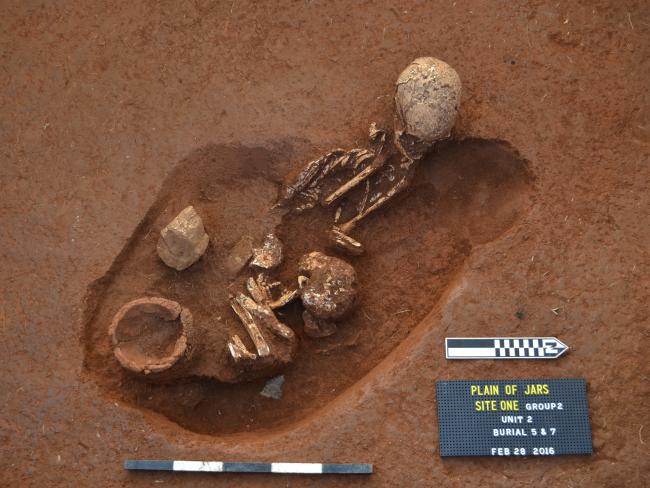
Australian scientists say mysteries still surround the ethnicity of thousands of remains found in these burial jars at Laos' Plain of Jars. Picture: Thonglith Luangkhoth
AN AUSTRALIAN archeologist has described the thrill of uncovering 2500-year-old human remains in central Laos’ Plain of Jars, marking a vital step in solving the mysteries of the region.
The Plain of Jars, in the central province of Xieng Khouang, has more than 90 jar sites, each containing from one to 400 stone jars.
The exact purpose of the jars, which date back to the Iron Age, remains unclear, along with the ethnicity of the people who left the jars, which weigh up to 10 tonnes each and were dragged from quarries up to 10km away.
“One of the big questions is what were the jars used for? And that’s something we hope we’ll be able to shed a little bit of light on,” said Dougald O’Reilly, the project’s chief investigator.
The project is building on research carried out by French archeologist Madeleine Colani in the 1930s who believed the jars were used for holding the dead.
The discovery of the human remains bears out this theory.

Australian and Lao scientists have uncovered these human remains dating back to the Iron Age, 2500 years ago, on Central Laos’ Plain of Jars, marking steps to unravel archaeological mysteries. Pic: Louise ShewanSource:AAP
The search at Site One, which boasts more than 300 stone jars, stone discs and markers, uncovered three forms of burial: internment of whole bodies, those of bundled bones, and bones inside ceramic vessels.
“It’s just so fascinating the amount of effort that was put into the mortuary aspect of the culture at this time,” said Dr O’Reilly.
The remains were detected using ground penetrating radar because there was nothing remaining in the jars themselves, which had been worn away by the elements over the space of 2000 years.
The ethnicity of the remains is a key question that has also not been answered.
“What I think is really exciting is the subsurface remains there, that the jar field at Site One must contain some thousands and thousands of individuals,” Dr O’Reilly said.
Research in the region was hampered for decades after bombing by the Americans during the Vietnam War left the area littered with unexploded ordnance that continue to cause problems.
“There are challenges. One has to be very careful with the unexploded ordinance (UXO). Laos is said to be the most heavily bombed country in the world and there is a huge amount of UXO littering the landscape,” Dr O’Reilly said.
The search sites have been cleared, which may lead to it being added to UNESCO’s World Heritage listing.
Dr O’Reilly is part of an Australian team that, along with their Lao counterparts, made the discovery in February during the first major work of a five-year project.
“For everybody involved, we’re really excited to have the opportunity to work at one of southeast Asia’s most important archaeological sites and probably one of the (region’s) least understood archaeological sites,” he told AAP.
The project is funded by the Australian Research Council and led by the Australian National University.













